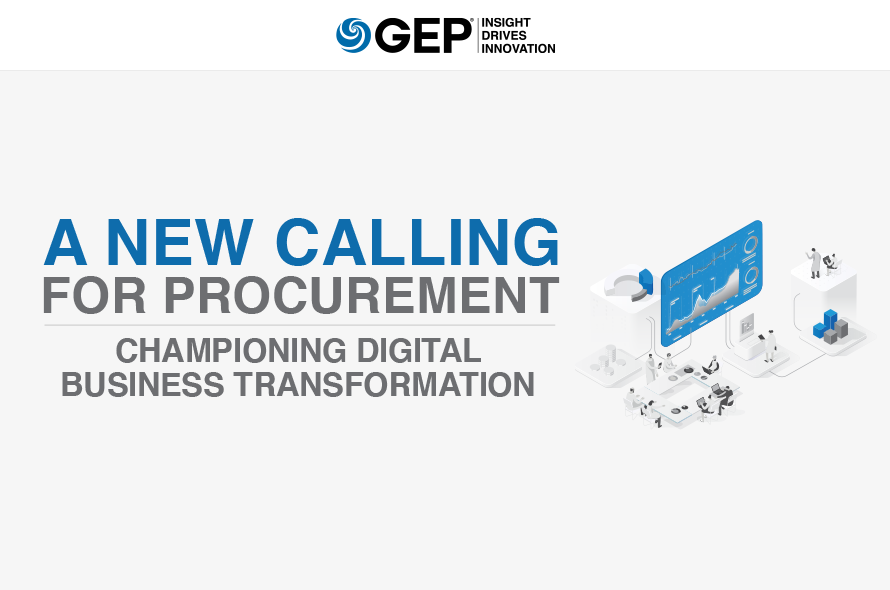Digital transformation has been a priority for many enterprises. The pandemic has only made it a pressing one.
But it involves significant spend and delivery risks. And with cash flows under pressure, there’s no room to leave any value on the table.
This is where your procurement team can shine.
A new GEP paper – A New Calling for Procurement: Championing Digital Business Transformation – discusses why and how your procurement team should be playing a larger, more active role in enterprise-wide digital procurement transformation.
It also explains how you can collaborate effectively with IT and function leaders to optimize value from digital investments.
What you’ll learn:
- Procurement’s role in building the digital road map
- 3 types of digital transformations and how to manage them
- How to partner with the right strategic suppliers
Read now to understand how your procurement team can be a strategic advisor and trusted business partner in the enterprise’s digital transformation journey.
Nearly every industry is on a digital transformation journey. Consumer goods companies are using technology to improve stock visibility. Banks are setting up digital sales channels. And health care providers are digitizing medical records for data insights.
The COVID-19 pandemic has only accelerated this trend, as organizations rapidly adopt digitalization for continued business amid restrictions and social distancing.
However, starting or fast-tracking a digital transformation journey is not simple: it involves significant thirdparty expenses and is fraught with delivery risks.
At a time when cash flows are weak and the margin for error is low, organizations would do well to turn to their procurement functions to support a smooth and cost-effective transformation. It is also the right time for procurement to reassess its value-add and adapt to the new normal that prioritizes digital transformation.
MOVING BEYOND TRADITIONAL METHODS
Kick-starting a company’s digital transformation program means a strong dependency on third-party partners, such as strategy consultants, software and product providers, and implementers.
However, many procurement teams are not properly equipped to enable such digital programs since they are more adept at traditional operations. This is because of their:
- Historical emphasis on seeking low prices
- Prescriptive sourcing approaches
- Lack of domain knowledge
- Delivery styles unaligned to agile methodologies
Yet, curtailing the procurement team’s role in digital transformation and letting IT or any other department do its own strategic sourcing has its own drawbacks. These include:
- Settling for a single-source vendor without full market review
- Limited commercial tension resulting in uncompetitive costs
- Underestimating benefits of real partnerships and effective vendor performance management
- Less-than-optimal contracts leading to cost and scope creep
ADOPTING A DIFFERENT, DIGITAL APPROACH
It is evident that procurement needs a different kind of brief to be able to effectively deliver on digital transformation programs.
While sourcing from vendors and managing supplier relationships for digital technologies, the function should not feel restricted by a single process.
Organizations need a multi-speed procurement function that can properly respond to the demands of different types of digital programs. For this, they must start with a robust framework for classifying these programs and their key requirements.
THREE TYPES OF TRANSFORMATION PROGRAMS
An organization’s choice of the program will depend upon the stage of its digital journey. This means procurement’s role in selecting partners will also vary accordingly.
Type 1: Strategic programs
These programs shape the digital transformation journey, either in its entirety or for specific parts. Examples of partners include lead system integrators and strategic consultants, who help define the road map or develop specific use cases, such as sandbox projects.
Type 2: Functional digital programs
These programs leverage mature as well as emerging technologies to deliver outcomes from Type 1 programs. In some cases, solutions are co-created with partners and cannot be tendered. In other cases, solutions are scoped out through partner workshops. Examples include implementing blockchain or AIpowered analytics. Suppliers can be product or software providers and implementation partners.
Type 3: Mature digital technology programs
These have well-defined and scoped requirements that are often an outcome of Type 1 or Type 2 programs. Examples include implementation of the Internet of Things (IoT) and robotic process automation (RPA).
WHAT IS NEEDED TO IMPLEMENT EACH PROGRAM
The requirements from procurement will vary across digital program types, but the key elements remain the same: ensuring flexibility and agility.
In Type 1 programs, the focus should be on cultural and capability fit of the supplier partner. For this, the organization’s business or digital teams will play an important role in partner selection. Procurement teams will offer support in market-scoping, developing the supplier landscape and preparing for negotiations.
Type 2 programs that are co-created with strategic partners should also be led by the business team, with support from procurement.
Also, for Type 2 and Type 3 programs (with more well-defined outcomes), the focus should be on finding the right partner through tendering. This will allow bidders to showcase their unique approaches — through workshops and proofs of concept (POCs).
Procurement should ideally lead the tender processes and negotiations. It should design the process to give suppliers flexibility in presenting a solution-oriented approach within the bounds of the organization’s technology architecture. Gathering requirements and defining constraints will be key and these must be included in the tender document.

GETTING THE MOST OUT OF TENDERS
It is important not to design rigid and prescriptive tender documents in the mold of traditional procurement exercises. The business team should clearly define the desired outcome. The tender should ensure that the goals of the digital program are met with while allowing bidders to demonstrate different paths to achieve that goal. A multi-phase and interactive tender process, such as workshops, often yields the best outcome.
Criteria to Pick Suppliers for Digital Programs
| Type 1: Strategic program | Type 2: Functional digital program | Type 3: Mature digital technology program | |
| Criteria for partner selection |
|
|
|
| Role of procurement teams |
|
|
|
HOW TO RELY ON THE EXPERTISE OF INCUMBENTS
Long-term relationships with trusted partners greatly contribute toward achieving the desired outcomes in digital transformation. And building on existing third-party relationships will only make the process smoother.
Bringing in trusted third parties
Digital transformation journeys are complex, with lots of moving parts and interdependent systems. The change can be made less arduous with the involvement of trusted third parties, who understand the complex legacy technology architecture within the organization.
Unfortunately, most organizations do not leverage these relationships to their fullest extent. There are often instances of incumbent third parties (who are already providing a digital product or service to the firm) not included in tenders for other aspects of digital transformation even when they have the capabilities.
This is due to siloed working within procurement and project teams and a consequent siloed approach to managing digital programs – i.e., evaluating suppliers only by the virtue of their performance in a specific project.
Going to strategic suppliers
The ecosystem of existing strategic suppliers should be leveraged to drive digital transformation within organizations. As they build up an understanding of the firm’s architectural nuances (often a legacy of tactical and siloed solutions), they will use their experience with other clients to provide tailored solutions to the firm and avoid the wrong turns a digital transformation journey typically entails.
This approach — of partnering with fewer (but more strategic) suppliers — results in using their experience and understanding of the unique situation at a firm to shape requirements and iteratively build robust solutions. There are ancillary benefits, too — like cost savings and process efficiencies.
The key for supplier relationship management (SRM) teams is to break down the silos and understand the potential of incumbent suppliers to contribute toward digital programs beyond their current scope.
Setting up cross-functional steering committees (with representatives from IT, innovation, digital, and procurement) for governance and high-level oversight of key suppliers are practical ways to eliminate siloed governance of suppliers.
Knowing what to ask suppliers
The organization must be strategic about how it interacts with different suppliers and should ascertain what are the different requirements of each type. The SRM governance framework should not be one-size-fits-all. It should rather consider the differences between product (or software) providers and service providers.
Product suppliers’ service-level agreements or key performance indicators would typically include availability of systems, customer uplift and other such metrics that can be tracked with accuracy.
Service suppliers, on the other hand, would be judged by their delivery of specific statements of work (SOWs) in terms of meeting acceptance criteria and delivery timeliness.
Additional metrics such as a supplier’s ability to innovate and generate further revenue for the organization should also be measured.
Classifying SuppliersThird parties in a firm’s supplier ecosystem can be bucketed into three sets based on their products and services: |
||
| Digital product suppliers for core capabilities and solutions to existing needs | IT consultants/service providers for implementing solutions, testing, ongoing support and BAU resource augmentation | Business/strategy consultants for expert insights and developing road maps |
Capturing value after supplier selection
Quality considerations when writing statements of work (SOWs), selection of commercial models, and ongoing performance monitoring are crucial to ensure that the value negotiated translates into value captured for the organization.
Digital projects typically work in agile methodologies, which pose challenges like:
- Cost creep
- New ways of working in the organization
- Limited potential to define ultimate deliverables
These can be managed by considering the following:
SOW quality
- Well-defined change identification and management methodologies
- Improved utilization of the definition of “done” and acceptance criteria
- Defined development methodology and clarification of where the SOW falls in the spectrum across waterfall and agile
Commercial models
- End-to-end target pricing
- Iterative pricing that updates costs and estimates for upcoming “drops”
- Performance-linked payments whereby a portion of the payment is to be held back until user stories of the sprint are completed. If a sprint is not delivered on time, there are penalties.
Performance monitoring
- Sprints need to be delivered by effort estimation, unless requirements change. These must be tracked through the change control mechanism
- Project management needs to define what constitutes “done” so that this can be tracked
- Story points and value points should be utilized by both the supplier and the project team. Stron project management is required to balance effort with the desired outcome (ROI)
PICKING A CLEAR DIGITAL ROAD MAP
While embarking on a transformational journey, organizations should engage their procurement teams to promote innovation, enhance delivery and reduce risk. Procurement can help see through this digital journey by:
- Building processes to manage unclear and evolving requirements
- Adopting ways of working dependent upon types of transformation
- Leveraging the supplier ecosystem by identifying and attracting the right supplier mix (like strategic partners and implementation partners)
- Enhancing performance management to focus on wider governance mechanisms
All these generally involve significant departures from the ways procurement teams traditionally operate. This means starting off with a clear digital road map, where procurement is not a bystander to digitalization but is a trusted partner.

